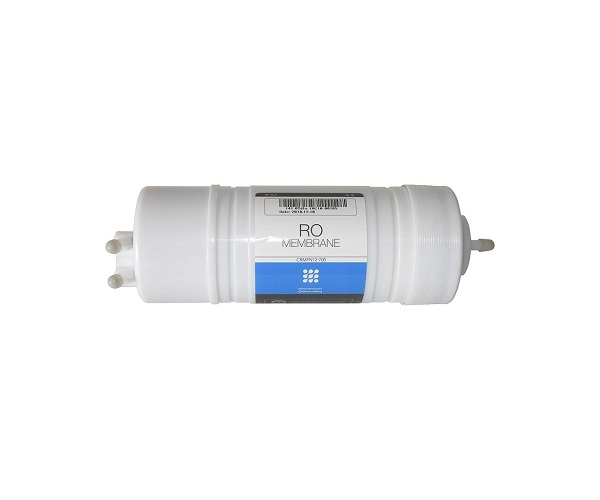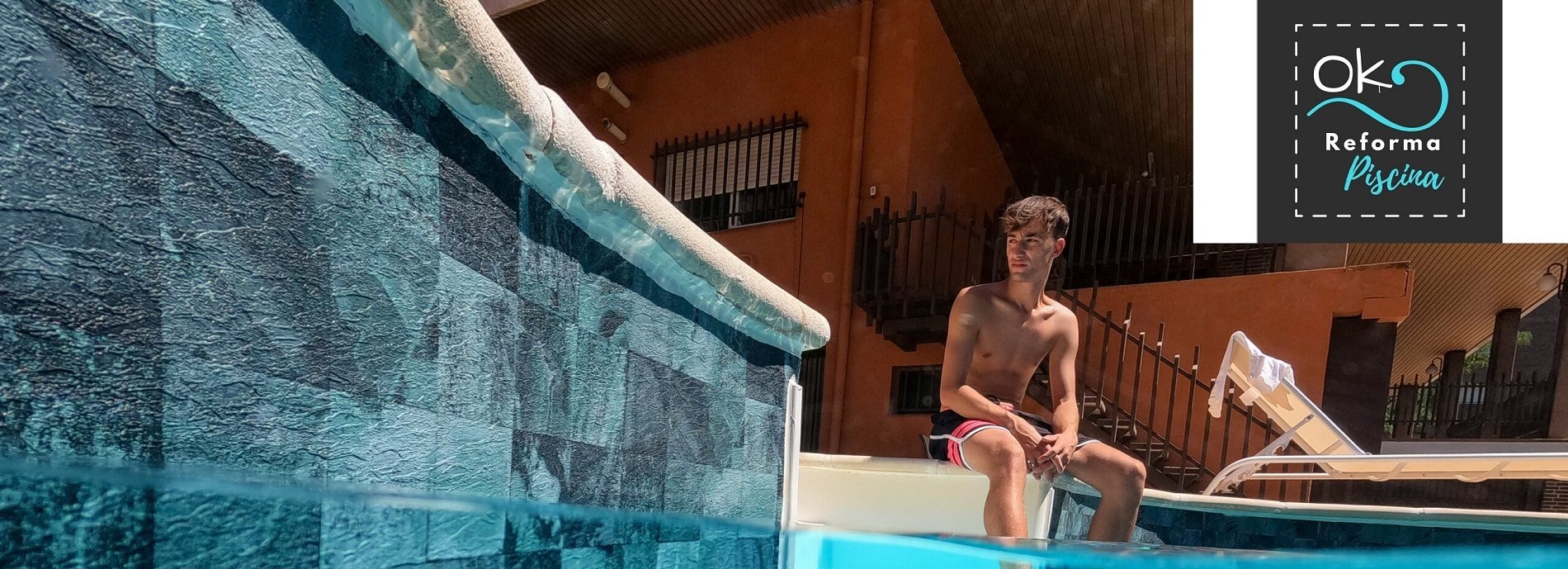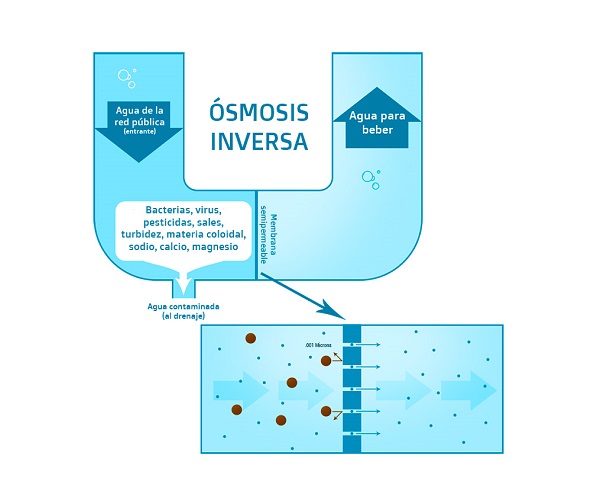
Table of contents of the page
En Ok Pool Reform and within Swimming pool water treatment We leave you this article about What reverse osmosis membranes should I buy?
What is reverse osmosis water treatment?
- Reverse osmosis has been considered the most advanced type of filtration that humans have invented to purify water. It uses membranes, where pure water can be separated from endless contaminants such as bacteria, parasites, viruses, pesticides and salts without using any type of chemical substances.
- It must be taken into account that only water passes through the semipermeable membrane, because its molecules are very small, while the larger molecules remain fixed to the membrane, obtaining completely pure water.

What reverse osmosis membranes for swimming pools to buy?
What factors to consider when purchasing an osmosis membrane
When it comes to choosing the right osmosis membrane for your pool, there are a few things you should keep in mind.
The first is the size of your pool.
- If you have a small pool, you may not need an expensive osmosis membrane. But if you have a large pool, you will definitely need one that is durable and can withstand the harsh chemicals used to clean your pool. You can find these membranes at most pool supply stores. Just make sure you get one that is compatible with your particular pool model.
The next thing to consider is the type of water you have in your pool.
- If you have hard water, you will need a different type of membrane than if you have soft water. Hard water can damage membranes, so it is important to get one that is made for that purpose. There are also membranes designed for saltwater pools. These are typically more expensive than those made for freshwater pools, but they will last longer and be able to resist chlorine and other chemicals used in saltwater pools.
Lastly, you should consider price when choosing an osmosis membrane for your pool.
- The price will vary depending on the brand, the size of the membrane, and the materials it is made of. You can find some very affordable options online, but you may have to pay shipping and handling charges. If you are looking for a high-quality membrane, you may want to look into purchasing one from a company that specializes in pool supplies. They likely have a better selection and will be able to give you a better price.
Now that you know what to look for when choosing an osmosis membrane for your pool, you can start shopping. There are many different styles and brands to choose from, so take your time and find the perfect one for your pool. It's an investment that will pay off in the long run, so make sure you get the best deal possible.

Types of reverse osmosis membranes
Models of reverse osmosis membranes for swimming pools
There are many different types of reverse osmosis membranes that can be used for swimming pools.
The most common type is the thin film composite (TFC) membrane. Other types include spiral wound membranes, hollow fiber, and reverse osmosis (RO). Each type has its own advantages and disadvantages.
- First of all, you have the TFC membrane It is the most popular type of reverse osmosis membrane, made up of a thin layer of polymer film that is sandwiched between two layers of porous material. Likewise, the porous material allows water to flow through it, but the polymer film rejects impurities such as salts and other dissolved contaminants.
- In second position you can find spiral wound reverse osmosis membrane, which is another popular type. It is actually made from a spiral polymer film tube that is wrapped around a central bar and this spiral design gives the membrane a large surface area, allowing it to reject more impurities than the TFC membrane.
- Then you have hollow fiber reverse osmosis membrane It is made of long, thin fibers of polymer film that are bundled together. The fibers are arranged in a hollow tube, and water flows through the center of the tube. However, the hollow fiber membrane has a very high rejection rate, but it is also very difficult to clean and maintain.
- And finally, RO membrane is the most expensive type of reverse osmosis membrane; which is made of a thin sheet of semipermeable material that is wound into a spiral. On the other hand, it is worth mentioning that the RO membrane is very effective in removing impurities, but it is also very fragile and can be easily damaged.

Osmosis membranes for brackish water
Reverse osmosis (RO) membranes are used to treat brackish water
Reverse osmosis (RO) membranes are used to treat brackish water to make it safe for consumption.
- Reverse osmosis membranes are widely used in industrial and municipal applications, providing safe and clean drinking water. RO systems are also increasingly being used in the home as they are an effective and economical way to treat tap water to make it safe to drink.
Brackish Water Membrane Procedure
The RO process requires brackish water to be pressed through a semi-permeable membrane, allowing pure water to pass through the membrane and the rest of the contents to be retained. These membranes are effective in removing salts, heavy metals, bacteria and other harmful contaminants from water.
Different reverse osmosis systems for brackish water
- Reverse osmosis systems used in the home They are usually composed of a pressure pump, a filter and an RO membrane. Tap water is sent through the filter before passing to the RO membrane. The pressure pump is used to increase the pressure of the water, allowing it to pass through the RO membrane. The purified water is collected in a container and stored for future use, while the contaminated water is discarded. Domestic reverse osmosis systems typically have a production capacity of between 50 and 300 liters per day.
- The reverse osmosis process for seawater treatment requires water to be pressed through a semi-permeable membrane, allowing fresh water to pass through the membrane and the rest of the contents to be retained. RO membranes are effective in removing salts, bacteria and other harmful contaminants from seawater.
Seawater treated with reverse osmosis is generally safer to drink than tap water, as it contains fewer impurities and contaminants.
- Reverse osmosis systems can be used to produce drinking water from unconventional sources, such as seawater. Seawater is a brackish water source that is increasingly being used to produce drinking water due to its availability and low cost.
- However, reverse osmosis treated seawater may not be suitable for all uses as it may lack some minerals essential for human health.
There are several different types of reverse osmosis membranes available on the market, and they can be selected depending on the intended use of the water.
- The most common RO membranes are fiberglass, polyethylene terephthalate (PET), and nylon.
The effectiveness of RO membranes depends on the type of contaminants present in the water.
- Bacteria and viruses are generally retained more effectively than other contaminants, such as salts and heavy metals.
- RO membranes can also be effective in removing volatile organic compounds (VOCs), such as chlorine, from water. However, some VOCs, such as trihalomethane (THM), can pass through the membrane and require additional treatment to be completely removed.
Reverse osmosis membranes are an effective technology for producing clean and safe drinking water. However, It is important to select the appropriate type of membrane for the intended use, as some types may not be effective in removing all contaminants present in water. Therefore, it is important to consult with a health professional before using reverse osmosis-treated seawater for drinking or cooking.

Types of reverse osmosis membranes according to their filtration fineness
Classification of separation membranes, according to the opening of their pores
Classification of separation membranes, according to the opening of their pores
There are three main types of separation membranes: microfiltration membranes, ultrafiltration membranes, and reverse osmosis membranes.
Thus, each type of membrane has a different pore size, which affects the efficiency of the separation process.
- Firstly, microfiltration membranes They have the smallest pore size and are generally used to remove particles larger than 0.1 microns to 1 microns (μm) from a liquid or gas stream.
- Secondly, the ultrafiltration membranes They have a slightly larger pore size and can be used to remove particles larger than 0.01 microns – 0,1 (μm).
- Thirdly, nanofiltration membranes from 0.001 to 0.01(μm)
- In the last place, reverse osmosis or hyperfiltration membranes, which have the largest pore size 0.0001 to 0.001 μm and can be used to remove dissolved molecules from a liquid or gas stream.
In general, the smaller the pore size of a separation membrane, the more expensive it is. However, smaller pore sizes also result in more efficient separations. For this reason, it is important to select the appropriate membrane for your specific application.

Types of reverse osmosis manufacturing materials
Materials used in the manufacture of the semipermeable membranes of this purification system

Cellulose acetate reverse osmosis membranes
The cellulose acetate membranes used in reverse osmosis are very strong and durable.
- For starters, these reverse osmosis membranes can withstand a wide range of temperatures and pressures, making them ideal for use in a variety of industries. These membranes are also relatively easy to clean and maintain, making them a good choice for many applications.
- Cellulose acetate membranes are also highly resistant to chemicals and other corrosive substances. This makes them an ideal choice for use in chemical processing and other industrial applications.
One of the main benefits of using cellulose acetate membranes is that they are very effective at removing impurities from water.
- They can remove a wide range of contaminants, including bacteria, viruses and sediment. This makes them an ideal choice for use in drinking water treatment and other applications where clean water is essential.
Another benefit of cellulose acetate membranes is that they are very efficient at rejecting salt and other dissolved minerals.
- This makes them an excellent choice for use in desalination and other water purification applications.

Polyamide osmosis membranes
What are polyamide osmosis membranes like?
- First of all, polyamide osmosis membranes are relatively inexpensive and easy to maintain, making them a popular choice for many applications.
- However, due to their porous structure, polyamide osmosis membranes can be damaged by pressure or heat, limiting their use in some applications.
- Additionally, polyamide osmosis membranes can also block ions, making them unsuitable for some applications where these ions are required.
- Polyamide osmosis membranes are generally thin and flexible, making them ideal for use in filtration applications.
- These membranes are made from a blend of synthetic polymers and have a porous structure that allows water molecules to pass through, but blocks larger particles.
What are polyamide osmosis membranes used for?
- Polyamide osmosis membranes are commonly used in industry to purify water as they can remove impurities such as chlorine, heavy metals and other contaminants.
- They are also used in medical applications, such as dialysis, where they are used to separate toxic substances from the rest of the blood.

Universal reverse osmosis membranes
What are universal osmosis membranes like?
- Reverse osmosis membranes are a very effective filtration technology used to purify water.
- They are characterized by their ability to remove impurities from water, such as bacteria, viruses and sediments.
- Reverse osmosis membranes are also capable of removing chlorine and other harmful chemicals from water.
- Most reverse osmosis membranes are made of a semi-permeable polymeric material that allows water to pass through it, while retaining impurities.
- Reverse osmosis membranes are extremely effective and can remove up to 99% of impurities from water.
- Additionally, reverse osmosis membranes are completely safe and do not release any chemicals into the water. This makes them ideal for use in homes and businesses. Reverse osmosis membranes are also often used in commercial and municipal water filtration systems.
Product Description Universal Reverse Osmosis Membranes
- Universal reverse osmosis membrane is a drinking water reverse osmosis membrane filter that adopts advanced technology to manufacture, it can provide superior quality water to residents, this is the highest performance membrane element, it can provide quality and performance consistent.
- Function: The hole of the RO membrane is as small as nano, uses an ultra-quiet pump to create high pressure osmosis to make the water molecule and ionic minerals pass through a layer of RO membrane, but inorganic salt , heavy metal, rubber mass, bacteria and viruses cannot pass through the RO membrane (the hole of RO membrane is only 0.00.0.00000000.000000001μm, but the diameter of the virus -0.4 or -0.μm) and retention.


